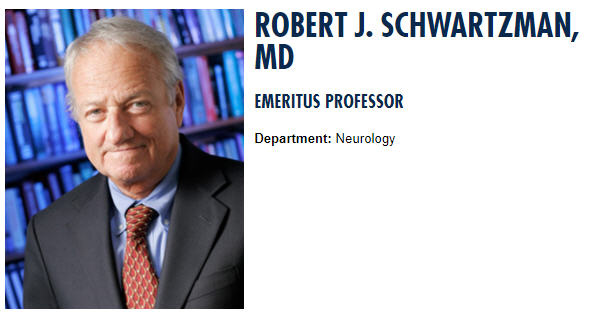
Tribute to Dr. Robert Schwartzman
1939 - 2021
With a heavy heart, the International Research Foundation for RSD/CRPS is saddened by the passing of our dear friend and colleague, Dr. Robert J. Schwartzman. Dr. Schwartzman was world renown and was known as the “Pioneer for RSD/CRPS.”
It is necessary to highlight Schwartzman's career milestones to become a leading neurologist in CRPS treatment.
In 1990, Dr. Schwartzman was the first to demonstrate that CRPS is more than just a pain disorder; it is a movement disorder.
Also, in 1991, Dr. Schwartzman was the first to publish a study that characterized the skin lesions in patients with CRPS.
In 2000, Dr. Schwartzman was the first to demonstrate that there were several patterns of spreading from the initial site of injury.
In 2007 Dr. Schwartzman collaborated with the International Research Foundation for RSD/CRPS to demonstrate, for the first time, that five-day anesthetic (coma) ketamine in the ICU was safe and effective for the treatment of refractory CRPS. This level of treatment results in a medically induced coma. Of the 20 patients in the study, complete remission from CRPS was observed at 1 month in all patients, 3 months in 17, and 6 months in 16 patients. If relapse occurred, significant pain relief was still attained at 3 and 6 months. Quality of life, the associated movement disorder, and the ability to work significantly improved in most patients at 3 and 6 months. 10 patients remain completely relieved of the pain; however, the treatment is not available in the United States.
In 2009, Dr. Schwartzman was the first to publish a well-controlled study at a relatively low dose of ketamine (maximum 25 mg/hour) in an outpatient setting demonstrated a significant reduction in many pain parameters. However, the study also suggested that a higher dose of ketamine is required for optimal pain relief. In addition, this was the first study utilizing an active placebo as a control.
In 2010, the International Research Foundation for RSD/CRPS again collaborated with Dr. Schwartzman and repeated the ketamine coma study. Again, all of the patients suffered from generalized CRPS. The patients had failed all treatments available, including low dose infusions of ketamine. The results of that second study provided a dosage guideline for maintaining an adequate depth of anesthesia to avoid hallucinations during the infusion period. In addition, the study pointed to pain thresholds as an objective and quantitative method for assessing clinical outcomes in patients with CRPS. The coma treatment is used to treat the most severe cases of CRPS.
In 2010, Dr. Schwartzman initiated a ten-year study with the International Research Foundation for RSD/CRPS to determine the optimal dose of ketamine necessary to treat CRPS outpatient. The study suggested that 4 days of treatment are sufficient for treating CRPS of the lower extremities. For the upper extremities, >4 days may be required. The study is the first to utilize quantitative sensory testing to direct the treatment of a chronic pain disorder.
Dr. Schwartzman in collaboration the International Research Foundation for RSD/CRPS are the only investigators who published information about the ketamine coma procedure worldwide. The 43 patients in the studies included children and adults with intractable CRPS. All research subjects who underwent the ketamine coma procedure had longterm benefits from treatment without serious complications from high doses of ketamine.
Although he is no longer with us, we are honored and privileged to have worked with him. While he may be gone, we will continue his passion in the pursuit to fight CRPS.
CNN report on CRPS in children
